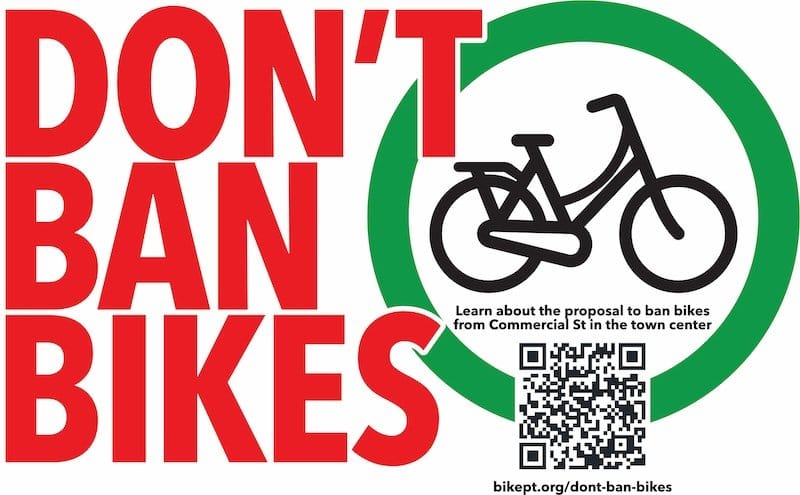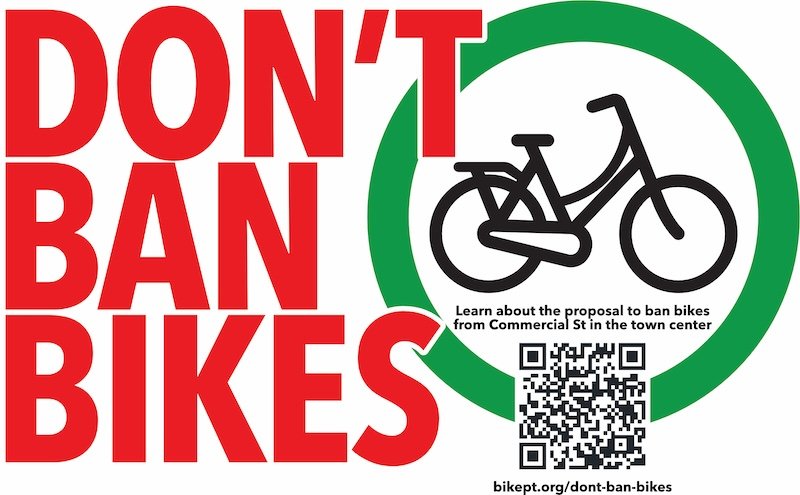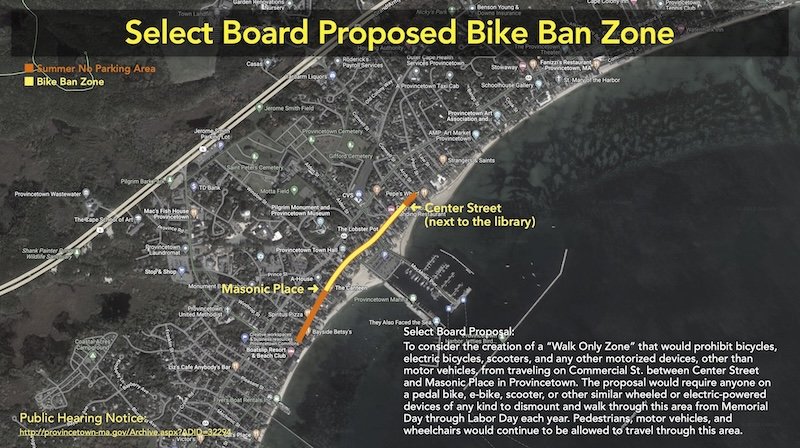Don’t Ban Bikes from Commercial St

UPDATE: The proposal was “indefinitely postponed” at the Select Board meeting on June 24.
Thanks to everyone for your efforts to let our elected officials know this was a bad idea!

The Provincetown Select Board is using recent crashes on Commercial St—none of which involved any bicycles—as a reason to ban bikes from Commercial St.
They’re holding a public hearing on June 24 on their proposal for a “walk only zone” in the center of town—but it would ban bicycles while still allowing cars.
It’s not a “walk only zone” if cars are allowed!
The Select Board is grasping at straws to find an easy solution to a complex problem.
Here’s the text of the proposal from the public hearing notice (PDF), with emphasis added:

To consider the creation of a “Walk Only Zone” that would prohibit bicycles, electric bicycles, scooters, and any other motorized devices, other than motor vehicles, from traveling on Commercial St. between Center Street and Masonic Place in Provincetown. The proposal would require anyone on a pedal bike, e-bike, scooter, or other similar wheeled or electric-powered devices of any kind to dismount and walk through this area from Memorial Day through Labor Day each year. Pedestrians, motor vehicles, and wheelchairs would continue to be allowed to travel through this area.
Why this is a Bad Idea
First, it’s illegal. Massachusetts law (Chapter 85, Section 11b) grants the right to operate a bicycle on all public ways that are open to motor vehicles. The Select Board can’t ban bikes without banning cars as well. The only exception is for limited-access highways (like an interstate), and there are no limited-access highways in Provincetown.
Second, it doesn’t address the safety problem. A recent injury was caused by a skateboarder who hit a person walking in the street. Last December, a dog was hit by a big SUV in the crosswalk at Standish St and had to be put down due to the injuries caused by the driver. These crashes had nothing to do with people on bikes.
Third, it will create more safety problems. Commercial St is a critical link in the town’s low-speed bicycle network. Hundreds of people ride their bikes along Commercial St every hour.
Shifting thousands of daily bike trips to Bradford St will create more conflict with cars and result in more serious injuries:
- There are no bike lanes and limited sidewalks on the parallel sections of Bradford St;
- Drivers regularly speed over the posted 25 MPH speed limit; and
- There are 10x more cars and trucks than on Commercial St.
Fourth, it will encourage more cars on Commercial St. Allowing cars but not bikes will encourage more folks to drive. Congestion on Commercial St will increase, since a single car takes up 10x the amount of space of a single person on a bike.
There are Better Solutions
Implement Best Practices to Make Commercial Street Safer
- Actively manage traffic. The town has officers on the street at key intersections directing traffic, but they have no authority to manage it. Set specific guidelines on how to determine when the street should be closed to bikes and motor vehicles. If the street is curb-to-curb with people walking everywhere, it’s time to put out a few traffic cones.
- Look at the data. Our traffic counter shows exactly how many people are walking, bicycling, and driving during daylight hours (except for times when a vehicle is parked illegally at the curb in front of it). Over 80% of traffic is people walking and bicycling. A blanket ban at all times for the entire season is not an effective way to promote safety—it just turns people into scofflaws.
- Lower the speed limit to 10 MPH or slower. That’s the standard recommendation for shared streets like Commercial St where people walking, riding bikes, and driving cars all mix in the same space.
- Install traffic calming. If people are riding too fast, change the street to slow everyone down.
- Daylight corners so everyone can see each other at intersections,
- Install raised crosswalks and speed tables at intersections,
- Install bollards to define walking spaces and prevent sidewalk parking,
- Drop the sidewalk curbs to street level to improve accessibility,
- Change the pavement color and texture to make it look more like a walking space.
- Enforce the no parking and loading zone regulations. Reducing the number of cars and trucks on the street opens up a lot of space for people who are not in cars. Getting a ticket for parking illegally is a pain, but it educates drivers about our local traffic regulations.
- Enforce loading zone hours. Trucks are on the street at all times of the day despite the loading zone regulation (4-6-1, p. 18) that says they are prohibited after 12 PM. Communicate to delivery drivers that they need to follow the rules, and issue tickets if necessary.
- Enforce “no parking” on sidewalks. Trucks and cars often park blocking the narrow brick sidewalk, rendering it completely useless.
- Enforce “no parking” in the seasonal parking ban area. Focus on the areas in front of Spiritus, Town Hall, and the library.
- Put parking enforcement officers on bikes and on foot rather than in cars so they see what’s happening from other perspectives.
- Designate specific pedicab pickup spaces. This would give pedicab drivers a legal place to wait for passengers just like the taxi cabs have.
- Develop clear, accurate educational materials and distribute them everywhere:
- Provide materials to tour bus passengers, ferry passengers, and everyone who parks in a staffed parking lot.
- Require hotels, inns, and short-term rentals to provide the same materials to their guests.
- Require the bike, scooter, and golf cart rental companies to post the materials permanently on every bike, scooter, and cart available for rent.
- Require the taxis and pedicabs to post the materials in their vehicles.
- Do a regular mailing to all residents and homeowners about our local traffic regulations.
- Develop a street safety training program for summer employees and offer it to all businesses in town.
- Provide bicycle education classes to residents through the town’s Recreation Department.
- Do broad and continuous public education campaigns. Visitors don’t know how they’re expected to behave on Commercial Street, so they do what they see others doing, and it creates a vicious cycle.
- Hang the Bicycle Committee’s “Slow down” and “Use lights at night” banners.
- Bring back the COVID-era ambassador program to hand out educational materials and talk to people on the street in a kind, welcoming manner. Ask the Town Crier to distribute them as well.
- Have Provincetown Community Television produce a series of videos that explain the regulations and how to safely navigate Commercial St.
Make Bradford Street Safer for Walking and Bicycling
- Lower the speed limit to 20 MPH.
- Daylight corners to improve sight lines.
- Enforce “no parking” zones, especially at the top of the hill at Prince St and at the Bas Relief.
- Add bike lanes where the street is wide enough, and remove on-street parking where necessary.
- Widen existing sidewalks so people can actually use them. The existing asphalt sidewalks are too narrow for a wheelchair and barely wide enough to walk single file.
- Add sidewalks where they’re missing or install bollards and paint to designate walking areas.
References
Public Hearing Notice, Proposal to Create a “Walk Only Zone” on Commercial Street Between Center Street and Masonic Place (PDF)
Massachusetts General Law, Chapter 85 Section 11b
Provincetown Parking & Traffic Regulations (PDF), Town of Provincetown
Shared Streets & Alleys, p. 51, City Limits: Setting Safe Speed on Urban Streets, National Association of City Transportation Officials (NACTO), 2020.
Commercial Shared Streets, Urban Street Design Guide, National Association of City Transportation Officials (NACTO), 2013.
